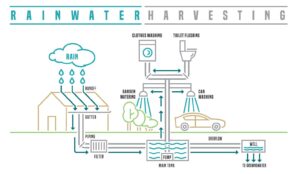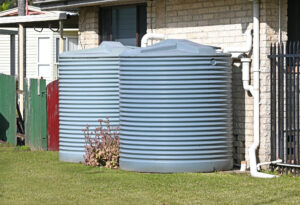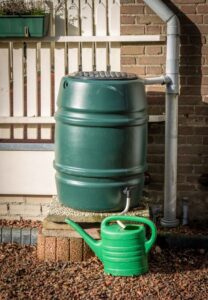Introduction
As a water-conscious individual, I’m always looking for ways to conserve this precious resource. That’s why I was so intrigued when I first heard about rainwater harvesting. Rainwater harvesting is the process of collecting and storing rainwater for later use. It’s an ancient practice that can be traced back to 4th century BC Mesopotamia.
Today, rainwater harvesting has become increasingly popular for its environmental and economic benefits. It can be used to supplement existing water supplies, reduce the use of potable water, and improve irrigation efficiency. Plus, it helps to protect rivers, streams and other waterways from runoff pollutants.

Overview of Rainwater Collection Systems
Rainwater harvesting can be done in several ways, including using gutter systems, cisterns, barrels and underground collection systems. Gutter systems are the most common type of rainwater harvesting system used today. They are installed on rooftops to collect rainwater as it runs off into gutters which then direct it into a designated storage tank or another container. Depending on the type of gutter system used, it is possible to collect thousands of gallons of water each year from a single roof. Other methods are cisterns, rain barrels, and underground collection systems.

Building a Gutter Rainwater Collection System
A gutter rainwater collection system can range from simple to elaborate. I have a simple gutter system collecting water off my shed into a barrel for watering plants nearby. If I can build it anyone can! Below is a more elaborate system plan but you can simplify it if you need to.
The first step in building a gutter rain collection system is to plan out your design by assessing the size of your home and the amount of rainfall in your area. Calculate the square footage of each roof section to determine how much water you’ll need to collect from each area. Consult with local environmental experts for advice on optimal water collection based on climate and geography.
Once you have an idea of the size and design, it’s time to shop for the necessary parts. Gutter systems come in a variety of materials, such as metal, plastic, and vinyl. Choose one that is weather-resistant and can handle heavy rainfalls. To ensure proper drainage, make sure to install the gutter system at least three feet away from your home’s foundation. This is important!
Next, you’ll want to install a gutter filter system. This will help prevent debris from entering your rainwater storage tanks and clogging the pipes. Consider investing in a first flush diverter, which is an important component of any efficient rainwater harvesting system. The diverter will collect the initial rainfall and divert it away from the water tanks, helping to reduce sediment buildup and bacteria accumulation in the water. You still want to filter the water.
Finally, you’ll need to connect your gutter system to your rainwater storage tanks. Be sure to use piping that is resistant to weather and corrosion, and be mindful of the type of fittings and connectors you choose. Lastly, consider adding a spigot or faucet near the tanks so you can easily access your rainwater for use.
Now that you have your gutter rain collection system up and running, you can reap the benefits of harvesting free water from the sky! If maintained properly, it can also last for many years with minimal upkeep.
Cistern Rainwater Collection System

A cistern rainwater collection system captures and stores rainwater from your roof to use in various applications. It typically consists of gutters, a downspout, filters, storage tanks, piping, and pumps.
First off, you will need to install the gutter system around the perimeter of your home’s roof. Your gutters should be made of a durable material, such as aluminum or galvanized steel, and should be deep enough to accommodate large storms. Make sure the gutters are angled properly so that water flows away from your home’s foundation.
Next you will need to add a downspout which will direct the rainwater from the gutter system into your storage tanks. It is important to install a filter on the downspout in order to prevent debris from entering the cistern.
The next step is to install your storage tanks, also known as cisterns, that will catch and store the collected rainwater. Cisterns come in many shapes and sizes depending on your needs, but typically should be made of either plastic or metal so they can withstand long-term exposure to the elements. These can be as large or as small as you need for your system and the roof you are collecting from. I know people who get all of their water this way.
Once your cisterns are installed you will need to add a pump in order to move the collected water from the storage tanks into any applications that require it. The pumps should be connected to your home’s electrical system and have filters that prevent any debris from entering the system.
Alternatively, if your system is elevated it is possible to use just gravity or set up a solar pump system if you are off grid.
Finally, you will need to connect your cisterns to the various applications that require water. This can be done with a series of pipes which should be properly insulated so they do not freeze during cold winter months. Make sure all connections are secure and there are no leaks in the system.
By following these steps you can easily install a cistern system on your property in order to collect and use rainwater. This will help reduce the amount of water you need from municipal sources and save money in the long run. With a little bit of effort, you can create an efficient rain harvesting system that will benefit both you and the environment!
Barrell Rainwater Collection Systems

Rain barrel collection systems are growing in popularity as a way to conserve water and save money on utility bills. They provide an easy way to capture, store, and use rainwater for various purposes such as gardening, lawn maintenance, or even household water needs. A rain barrel is simply a large container that collects the runoff from your roof after it rains. This runoff water is then stored in the barrel and can be used for a variety of purposes.
The most important part of installing a rain barrel collection system is ensuring it is properly connected to your home’s gutter system. This involves connecting a downspout from the roof to the top of the rain barrel, which will direct all flowing water into it. To ensure the water is directed efficiently, you may need to add a diverter attachment to your downspout. Most barrels come with overflow valves and many can be connected together to make larger systems.
Once your rain barrel is connected and ready to use, it’s important to take some safety measures.
You may need to insulate or add a heater to keep it unfrozen in the winter. if you are using an electric-powered heater be sure to ground everything properly to avoid any risk of shock. Additionally, it’s important to check the seal around your roof downspout regularly to make sure that no water is leaking out. You will also want to direct any overflow away from your foundation.
Rain barrel collection systems are becoming increasingly popular among homeowners as a way to conserve and reuse rainwater in an affordable and environmentally-friendly way. With some basic tools and supplies, installing a rain barrel collection system is an easy project that can provide numerous benefits for your home.
The steps outlined above will help you get started with setting up a rain barrel collection system at your home. Although it may require some initial investment of time and money, it’s an excellent way to save money, conserve water, and help the environment.
If you’re ready to get started with setting up your rain barrel collection system, take the necessary steps to ensure that it is installed properly and safely. Then, sit back and enjoy the benefits of having a free source of water for outdoor projects or household use. You’ll be happy you took the time and effort to do it!
Underground Collection Systems for Rainwater Harvesting
Underground collection systems are also an option for rainwater harvesting. These systems involve catching and storing the water in an underground cistern or tank, from which it can be retrieved when needed. The water is collected via gutters that drain to a pipe system embedded in the ground. This pipe system then feeds the cisterns with the harvested rainwater.
Advantages of underground collection systems include the fact that they are hidden from view, offer improved water quality due to reduced exposure to sunlight and airborne particles, and require less maintenance. Additionally, these systems can make use of a larger area for harvesting rainwater than above-ground systems.
However, there are some disadvantages to installing an underground system for rainwater harvesting. The installation process can be complicated and expensive, and the system may not always work optimally due to potential flooding or clogging of pipes if the flow rate is too high. Additionally, these systems are more difficult to inspect than above-ground systems for any necessary maintenance or repairs.
Overall, an underground collection system for rainwater harvesting can provide an effective solution for many households and organizations. If you choose to install one, make sure that you consult a professional to ensure that it is installed properly and safely. Then, sit back and enjoy the benefits of having a free source of water for outdoor projects or household use. You’ll be happy you took the time and effort to do it!
Air to Water Generators?
An air to water generator is essentially a dehumidifier hooked up to a water purification system. You end up with distilled water that you then add minerals back to. This can produce 30 gallons of drinking water a day depending on your humidity and size of dehumidifier.
My problem with this method are as follows:
- You need power to run it and I prefer a passive approach.
- The system is somewhat expensive to set up. A dehumidifier can be several hundred dollars.
What I see as useful about this system are as follows:
- It can be used as a backup system for your well or if the water system is compromised. This has happened in several areas due to storms, most recently Jackson Mississippi was recently without drinking water for some time.
- It can provide excellent quality water for your water storage system.
I will not put anything on my sites I find to be basically useless in my opinion. To that end when I searched for a resource regarding this to sell, because of course I want to make money on my blogs, the one I found and bought on click bank was totally useless. I’m not going to name it though maybe I should, I’m just going to say be careful of clickbank and it’s ilk and if I put a clickbank item on my site I will have bought from the publisher and reviewed their contents.
For a very good example of how to build this system here is a you tube link for free and frankly way more informational than the clickbank product I wasted my money on. Be sure to read the comments as they have good information such as using RV drinking water hose instead of a regular hose.
After seeing what happened in Jackson, I am considering building one of these just as a backup. But overall you might be better off having water storage and a means to purify your water on hand. My suspicion is any storm big enough to flood the water system may also cause power outages.
Best Practices for Collecting and Storing Rainwater
The best practices for collecting and storing rainwater begins with understanding the local regulations, which vary greatly from state to state and region to region. It is best to consult a local expert or research your area’s specific regulations before beginning. I’m lucky enough to live in an area with limited regulations but you still want to be sure you are safe and do not cause damage to your home.
After confirming that it is legal to harvest rainwater in your area, you should take some necessary steps to ensure the best results. This includes selecting an appropriate size tank, installing the correct type of filter or pre-tank treatment system to remove soil particles and contaminants, and setting up a diversion from your downspout or roof gutter to direct water into the tank.
After installation, it is important to keep the system clean by regularly inspecting and cleaning both the tank and the filter system. Additionally, it is important to regularly check the pH of the water and ensure that it remains within a safe range. Finally, installing a vent on your tank can help prevent any build-up of air pressure inside the tank, which could lead to damage or leaks.
By following these simple best practices for collecting and storing rainwater, you can ensure that you are able to harvest and use the water safely and effectively. With a properly installed rainwater harvesting system, you’ll have access to an abundant supply of free, fresh water for many years to come!
So if you’re ready to take advantage of this natural resource, consider installing a rainwater harvesting system on your property today. And when you do, make sure to follow these best practices for collecting and storing rainwater in order to ensure that you get the most out of your system.
Selecting the Collection Method.
When it comes to collecting rainwater, there are a few different methods you can use depending on your needs and preferences. The simplest type of system is a passive collection system, which utilizes gravity to collect water from your roof into an underground cistern or above-ground storage tank. Active systems involve the use of pumps to move water from one location to another and are commonly used to collect water from a larger body of water such as a lake or pond.
If you are looking to install a rainwater harvesting system on your property, it’s important to choose the collection method that is best suited for your needs and budget. Consider factors such as the size of your storage tank, local weather conditions, and the quality of your roofing materials when selecting the best collection method for you. Additionally, research local laws and regulations regarding rainwater harvesting to ensure that your system is compliant with all applicable codes.
Also, make sure to examine the surface of your roof and gutters before collecting water from them so you can ensure that no hazardous substances such as dirt or debris are entering your storage tank. This will help keep your system in good working order and prevent contaminants from entering your water supply.
Finally, talk to a professional if you have any questions about selecting the best collection method for your needs. A professional can provide you with advice on which type of system is best suited for your property and local area. With their guidance, you can find the right rainwater harvesting system for your home or business.
Rainwater harvesting can be a cost-effective and sustainable way to ensure a reliable water supply on your property. With the right collection method, you can save money while collecting an abundant source of free water that can be used for watering your garden, animals or even drinking with the proper filtering and purification.
Maintenance Requirement of Rainwater Harvesting Systems
Maintenance requirements of rainwater harvesting systems are very low. Regular checkups of your tank and other components, such as the pipes, valves, filters, and pumps should be done at least once a year to make sure it is working correctly. Additionally, if any signs of wear or corrosion are noticed on your system, it’s important to have them addressed as soon as possible.
By following these tips and performing routine maintenance on your rainwater harvesting system, you can ensure that it works properly and continues providing clean water for years to come.
Taking advantage of rainwater harvesting is a great way to be environmentally friendly while also saving money. With just a few simple steps, you can be well on your way to collecting free water from the sky!
Summary of the Advantages of Rainwater Harvesting
Rainwater harvesting is a cost-effective and sustainable way to provide water for residential and commercial properties. It provides an abundant source of free water that can be used for watering gardens, and animals, or even drinking with the proper filtering and purification. The maintenance requirements are also low, requiring only annual checkups and repair of any signs of corrosion or wear. Rainwater harvesting is a great way to help the environment while also saving money, making it a sensible choice for any homeowner.
In conclusion, rainwater harvesting is a great way to take advantage of an abundant and renewable resource while also helping the environment. It is easy to maintain and provides both economic and environmental benefits. Thus, it is well worth considering for any property owner looking to reduce their water bills and be more eco-friendly.
Resources for Further Information on Rainwater Harvesting
https://byjus.com/biology/rainwater-harvesting/
https://rainwaterharvesting.tamu.edu/


